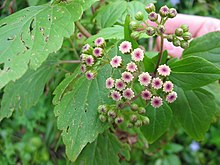Ageratina
| Ageratina | |
|---|---|
 |
|
| Sticky Snakeroot (Ageratina adenophora) | |
| Scientific classification | |
| Kingdom: | Plantae |
| (unranked): | Angiosperms |
| (unranked): | Eudicots |
| (unranked): | Asterids |
| Order: | Asterales |
| Family: | Asteraceae |
| Subfamily: | Asteroideae |
| Tribe: | Eupatorieae |
| Genus: |
Ageratina Spach |
| Species | |
|
About 250, see text |
|
About 250, see text
Ageratina (snakeroot) is a genus of more than 330perennials and rounded shrubs in the family Asteraceae.
These plants grow mainly in the warmer regions of the Americas and West Indies. Over 150 species are native to Mexico. Some flourish in the cooler areas of the eastern United States. Two Mexican species have become a pest in parts of Australia and Taiwan.Ageratina used to belong to the genus Eupatorium, but it has been reclassified.
The inflorescence consists of multiple fluffy, red or pinkish-white capitula in clusters. These lack the typical ray flowers of the composites.
They have multiple, much-branched woody stems. The petioles are rather long. The leaves are triangular, serrate and opposite with a foul-smelling, musky scent.
Milk from cows that have eaten snakeroot can cause illness if ingested because the milk becomes toxic. Symptoms of milk sickness include vomiting.
Ageratina pichinchensis is a traditional Mexican treatment for superficial fungal infections of the skin. These plant extracts contain encecalin which has activity to inhibit and kill the fungus. Studies have compared its effectiveness in treating toenail fungus with ciclopirox.
Long used in India to treat snakebite, epilepsy, mental disorders. It was also discovered to be useful in regulating hypertension discovered in 1949, but it causes various side effects. Used to treat schizophrenia due to the alkaloid reserpine it contains.
...
Wikipedia
